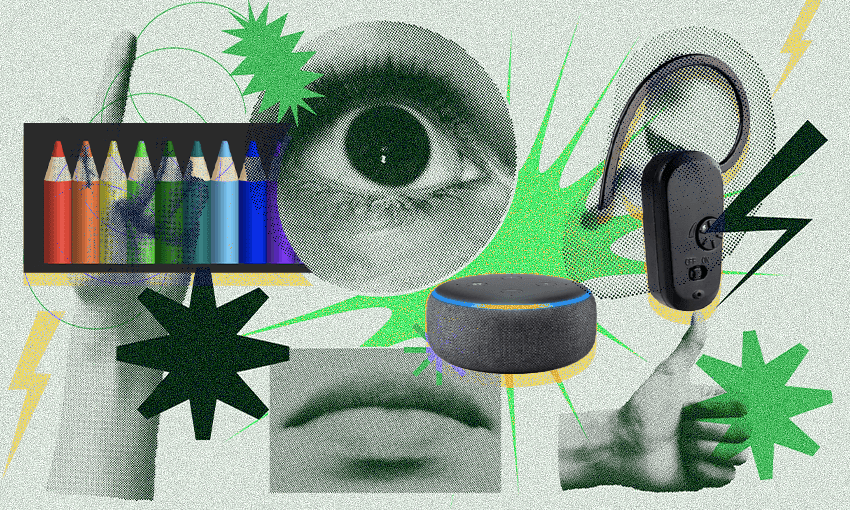It’s easy to take for granted, but technology exists to help us. The Spinoff spoke to four disabled people about the tech they consider essential.
We often think of technology as irking us – Duolingo scolds, Instagram pesters and TikTok steals time. But, if I did throw my phone out the window of a speeding car, what would wake me up in the morning?
For the one in four New Zealanders who have a disability, technology can be even more essential. Features and products that the other three quarters of people take for granted can be crucial for people’s ability to live independently and participate fully in society.
One NZ retail employees see customers coming into stores with access needs every day, seeking advice on the best device for their needs, or how to alter settings on their current device to best utilise vision or audio features – setting up devices by changing font sizes, adding colour filters, or finding the best ring tone at a comfortable frequency. These small changes can make a big difference to customers connecting with loved ones or accessing crucial information on their devices.
Below, a range of people tell us about a technology they find essential in their everyday lives.
Natasha Gallardo – chief executive of the National Foundation for Deaf and Hard of Hearing
What is a piece of technology you find essential?
My Bluetooth hearing aids are essential, I’ve been using them for roughly five years.
How do you use them from day to day?
I use the Bluetooth connectivity everyday to play music, watch my favourite shows, and talk to people on the phone. I answer the phone directly into my hearing aids, which means I can hear clearly and don’t have to pick up the phone. I can also connect Netflix, or Zoom calls, directly to my hearing aids. It means I can hear conversations clearly without captions.
What did you do before Bluetooth hearing aids were available?
There was no technology available like this when I was growing up and diagnosed with hearing loss as a teenager so it made all the everyday tasks challenging back then – like talking on the phone which became near impossible to do until bluetooth hearing aids became available.
Are they popular in the Deaf and Hard of Hearing community?
Yes for newer models of hearing aids, behind the ear options and for those in the upper range too. Not all hearing aids are the same so not all have this capability but I wish it was available for everyone as it makes life so much easier.
Julie Woods – ‘That blind woman’
What is a piece of technology you find essential?
I love my Alexa Smart Speaker. I was alerted to Alexa around five years ago, when I was having some adaptive technology lessons. The instructor came to teach me something else and on the way out, said “have you heard about these smart speakers?” And now we’ve got not one but four in our apartment. They’ve all got different names. There’s Alexa and Ziggy and Amazon and Echo, and they’re all connected.
How do you use Alexa, Ziggy, Amazon and Echo?
I use them everyday for loads of things, like asking what’s the time, what’s the population of Spain, what’s the phone number of Briscoes, how do you spell bureaucracy, and play relaxing guitar on Spotify. Also with the speakers I can access podcasts, Ted Talks and the Talking Book Library.
What did you do before you had them?
I went blind 26 years ago. You can learn to do things in different ways, that’s what I had to do. I had to stop seeing and instead smelling, hearing, tasting and touching. I use my other senses to receive information. Now I read with my ears and my fingers.
I can access the internet through a computer, with the program JAWS which reads the screen. But there’s quite a few steps involved in that, for me as a blind person. It’s one tool in the toolbox, but the more ways you can do the same thing, the better.
Are smart speakers popular in the blind community?
When somebody goes blind, and they become a member of Blind Low Vision NZ, they automatically get an Alexa. It’s great. There’s been a massive change in 26 years. I heard about a member of Blind Low Vision NZ who had a fall and asked Alexa to phone his sister and call an ambulance. It’s great for safety.
Áine Kelly-Costello – disability advocate, storyteller, PhD candidate
What is a piece of technology you find essential?
The camera on my phone is a pretty essential accessibility function for me, and many blind people.
How do you use it?
There’s apps, like Seeing AI or Envision, which can read text to you. And so together with the camera, I can access printed text (think food labels, medication labels, reading the post, sometimes bus stop signs…). The apps try to account for the fact that a blind person is going to need some assistance getting a good shot. But they’ll only get you so far, sometimes you actually need a human on the other end.
With a camera phone I can also video call a sighted person to check some random visual thing – there are some things you don’t want to have to figure out for yourself, like if a dog threw up on the carpet, or they can give an opinion on colour coordination of clothing.
This wouldn’t be possible with a voice call alone, and it wouldn’t be possible with a camera that isn’t a phone.
Have you grown up being able to use your phone like this?
Optical character recognition has improved a lot these last few years. When I was younger, I probably wouldn’t have needed it to the same extent. But there were always battles – some teachers and lecturers didn’t cooperate and gave grades and feedback handwritten on a page. It’s only starting to get to the point now where OCR can sometimes manage handwriting, but it depends on the person. Examiners are quite notorious for having illegible handwriting.
I didn’t realise how useful a camera phone can be for a blind person
It’s a good example of common technologies that can have supplementary functions. But, ultimately, we’ll never be able to only use mainstream features – I’m definitely going to need my phone to talk to me and sighted people don’t necessarily need that.
Gabrielle Hogg – student at AUT, majoring in social sciences
What is a piece of technology you find essential?
I use the colour filters on my MacBook and iPad to help me read and process better.
How long have you been using them?
I’ve been using colour filters in my glasses since my early 20s (I’m currently 35). I did not get a MacBook till I was about 25, I’ve been using the filters ever since. It’s something I do all the time. Colour filters are commonly used for Irlen Syndrome, a visual processing perceptual disorder, and in the neurodiverse community. Often people use them without realising they in fact have Irlen syndrome too.
How do they work?
With the coloured filters, I can choose a colour to look through what I am reading or watching on my laptop and iPad. It doesn’t remove colour altogether. It doesn’t change the effect of the image, or video, or written words when you have Irlen syndrome – it actually makes it clearer and easier to see, it enhances the image.
What did you do before you used coloured filters?
Before, I struggled a lot to get assignments done, and to read and take in what I was reading, without getting headaches, or concentrating issues. Technologies such as Apple products are often taken for granted by the general population, but for me, they have many accessibility features that no other products have.

